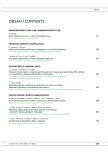Lumbar Intradural Disc Herniation Manifesting as Cauda Equina Syndrome – Case Report
Authors:
J. Mraček
Authors‘ workplace:
Neurochirurgické oddělení FN Plzeň
Published in:
Cesk Slov Neurol N 2008; 71/104(5): 594-598
Category:
Case Report
Overview
Lumbar disc herniation is a very frequent diagnosis. In exceptional cases a herniated sequestrum may penetrate the dura mater intrathecally. The clinical effects do not differ significantly from standard extradural herniation. Post‑contrast magnetic resonance imaging should function as a reliable diagnostic method at present. In spite of this, the intradural location of the sequestrum is very often only determined during surgery. Differential diagnosis should be considered for intradurally growing tumours. Microsurgical techniques must be used to remove the sequestrum and free the nerve tissue. The main cause of penetration of intradural space in herniation is thought to be adhesion between the dura mater and the posterior longitudinal ligament. The authors present a case of intradural herniation of lumbar disc L2/3, which led to cauda equina syndrome as a clinical consequence.
Key words:
intradural disc herniation – lumbar disc herniation – cauda equina syndrome – magnetic resonance imaging – microsurgery
Sources
1. Kataoka O, Nishibayashi Y, Sho Y. Intradural lumbar disc herniation: Report of three cases with a review of the literature. Spine 1989; 14(5): 529–533.
2. Dandy WE. Serious complications of ruptured intervertebral disc. JAMA 1942; 119 : 474–477.
3. D‘Andrea G, Trillò G, Roperto R, Celli P, Orlando ER, Ferrante L. Intradural lumbar disc herniations: the role of MRI in preoperative diagnosis and review of the literature. Neurosurg Rev 2004; 27(2): 75–80.
4. Mikula F, Zapletal B, Fiser Z. Intradurale Prolapse der Lendenbandscheibe. Zbl Neurochir 1960; 20 : 326–333.
5. Mikula F. Clinical picture of intradural sequestration of the lumbar intervertebral disk. Čas Lék čes 1964; 103 : 736–739.
6. Zinek K, Brož T, Hájek P, Radvaková D, Opšenák R. Kazuistiky intradurální hernie disku v lumbální oblasti – vzácná příčina lumboischialgie. Neurol pro praxi 2006; 4 : 219–221.
7. Blikra G. Intradural herniated lumbar disc. J Neurosurg 1969; 31(6): 676–679.
8. Choi JY, Lee WS, Sung KH. Intradural lumbar disc herniation – is it predictable preoperatively? A report of two cases. Spine J 2007; 7(1): 111–117.
9. Negovetić L, Cerina V, Sajko T, Glavić Z. Intradural disc herniation at the T1–T2 level. Croat Med J 2001; 42(2): 193–195.
10. Smith RV. Intradural disc rupture. J Neurosurg 1981; 55(1): 117–120.
11. Mut M, Berker M, Palaoğlu S. Intraradicular disc herniation in the lumbar spine and a new classification of intradural disc herniations. Spinal Cord 2001; 39(10): 545–548.
12. Barberá J, Gonzales-Darder J, Garcia--Vazquez F. Intraradicular herniated lumbar disc. Case report. J Neurosurg 1984; 60(4): 858–860.
13. Süzer T, Tahta K, Coşkun E. Intraradicular lumbar disc herniation: case report and review of the literature. Neurosurgery 1997; 41(4): 956–959.
14. Cleveland Clinic Alumni Newsletter 2004; 25 : 32.
15. Snow RD, Williams JP, Weber ED, Richardson PH. Enhancing transdural lumbar disk herniation. Clin Imaging 1995; 19(1): 12–16.
16. Hidalgo-Ovejero AM, Garcia-Mata S,Gozzi-Vallejo S, Izco-Cabezón T, Martinez--Morentín HJ, Martinez-Grande M. Intradural disc herniation and epidural gas: something more than a casual association? Spine 2004; 29(20): 463–467.
17. Lee JS, Suh KT. Intradural disc herniation at L5–S1 mimicking an intradural extramedullary spinal tumor: a case report. J Korean Med Sci 2006; 21(4): 778–780.
Labels
Paediatric neurology Neurosurgery NeurologyArticle was published in
Czech and Slovak Neurology and Neurosurgery

2008 Issue 5
Most read in this issue
- Lumbar Intradural Disc Herniation Manifesting as Cauda Equina Syndrome – Case Report
- Current Diagnostics and Therapy of Oligodendrogliomas
- Neurological Disorders in Critical Illness
- Neurosarcoidosis: a Rare Case of Sarcoidosis of the Cervical Spinal Cord – Case Report
